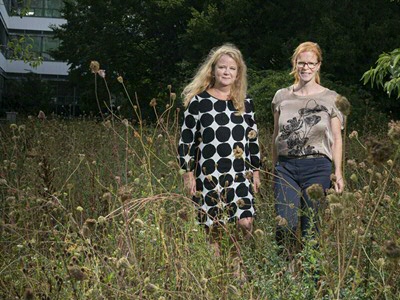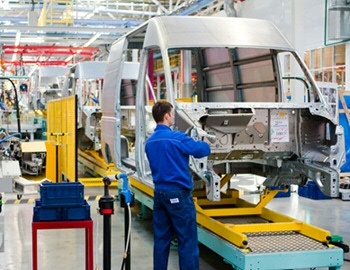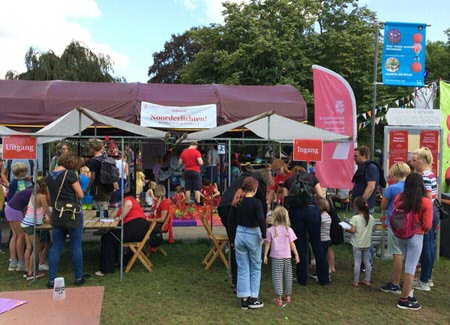Laten zien dat het kan
Beiden zijn jonge hoogleraren scheikunde aan het Zernike Institute for Advanced Materials (ZIAM) en beiden kwamen ze in 2018 naar de RUG. Behalve dat ze nieuwe materialen ontwikkelen, hebben Moniek Tromp en Marleen Kamperman nog meer gemeen: ze treden graag als wetenschapper naar buiten én worden gezien als rolmodellen.

Om met dat laatste te beginnen: wie zijn hun eigen rolmodellen? Moniek Tromp en Marleen Kamperman blijven het antwoord schuldig. 'Ik heb echt geen idee', zegt Tromp. 'Dat wordt me altijd gevraagd, maar ik had niet echt een rolmodel. Ik heb laatst mijn moeder genoemd. Zij werkte ook altijd en was er thuis ook, maar dat was niet binnen het vak.' Ook Kamperman haalt haar schouders op: 'Ik heb nooit in een onderzoeksgroep voor een vrouwelijke hoogleraar gewerkt of zo.' Als dat niet het wezenskenmerk is van het ware rolmodel voor vrouwelijke bètawetenschappers: rustig je eigen gang gaan in de mannenwereld die de bètawetenschappen met name vroeger waren en je daar pas achteraf over verbazen – waarover later meer.
Duurzame katalysatoren
Tromp en Kamperman richten zich aan de RUG op het maken van nieuwe materialen, maar doen dat beiden vanuit een andere insteek en voor verschillende toepassingen. Tromp houdt zich als hoogleraar Materiaalchemie met anorganische materialen bezig: materialen die metalen bevatten, zoals metaaloxides en zouten. 'Het zijn materialen die we gebruiken voor batterijen, brandstofcellen en als katalysatoren om uitlaatgassen van auto's op te schonen of bepaalde chemicaliën of medicijnen te maken', legt Tromp uit. 'Veel katalysatoren die in de zware industrie worden gebruikt, zijn ooit ontwikkeld toen er nog niet werd nagedacht over de gevolgen voor het milieu. Ze zijn bijvoorbeeld gebaseerd op schaarse edelmetalen als palladium en platina, grondstoffen uit politiek instabiele gebieden of produceren toxische bijproducten, afval. Om daarvan af te komen, proberen we duurzamere katalysatoren te ontwikkelen, op basis van grondstoffen die wel voldoende in de natuur aanwezig zijn of processen te ontwikkelen die minder afval produceren.'
Een belangrijk deel van haar onderzoek bestaat uit het zelf ontwikkelen van technieken om de onderzochte materialen te bekijken en te karakteriseren. Tromp ontwikkelde daarvoor bijvoorbeeld een eigen spectrometer, gebaseerd op röntgenstraling. 'Zoals je met röntgenstraling botbreuken kunt bekijken, gebruiken wij röntgen om te kijken naar atomen en moleculen, en te onderzoeken hoe ze onder verschillende omstandigheden reageren. Zo kunnen we de structuur en elektronische eigenschappen van materialen karakteriseren. Voor metingen met röntgenstraling moesten we altijd naar zogenoemde synchrotrons, grootschalige faciliteiten in bijvoorbeeld Frankrijk, Zwitserland of Engeland. Maar omdat het niet gegarandeerd is dat je daar altijd tijd krijgt toegewezen en het ver weg is, hebben we nu zelf spectrometers ontwikkeld, die we 24 uur per dag in ons eigen lab kunnen gebruiken.'

Autoindustrie
Op die manier kan Tromp bijvoorbeeld onderzoeken waarom bepaalde batterijen exploderen en hoe het ontladen van batterijen werkt. 'Aan de ene kant is het heel fundamenteel onderzoek om naar dat soort mechanismes te kijken, maar als je begrijpt hoe dat werkt, heeft dat een hele praktische, directe toepassing.' Daarom werkt Tromp in haar onderzoek veel samen met bedrijven uit de auto-industrie en de katalyse-industrie, zoals Varta en BMW.
Samenwerking met het bedrijfsleven? Hoe gaat Tromp om met een dergelijk – voor het grote publiek – heet hangijzer? De vraag is nog niet gesteld, of er klinkt al besmuikt gelach. 'Ja, omdat je het een heet hangijzer noemt', zegt Tromp. 'We werken nu met een groot bedrijf aan een katalysator die ze volgend jaar in hun fabriek moeten hebben. Omdat ze dat zelf niet kunnen, komen ze bij ons voor de fundamentele kant van het onderzoek. Je moet goede afspraken maken en op je strepen blijven staan, maar dat kunnen we onafhankelijk uitvoeren. Je moet zorgen dat je je eigen ding kunt doen en kunt publiceren. Dat is voor aio's en postdocs natuurlijk heel belangrijk.'
Onderwaterlijm
Kamperman houdt zich oneerbiedig gezegd bezig met plastics, zoals de lange, organische moleculen die polymeren zijn in de volksmond vaak worden genoemd. 'Ik kijk naar zachtere materialen die geschikt zijn voor onder meer biomedische toepassingen. Mijn focus ligt nu op lijmen die goed hechten op natte oppervlakken. Die kunnen bijvoorbeeld in het menselijk lichaam worden gebruikt, om wonden te lijmen in plaats van te hechten. Momenteel werk ik ook aan een projectvoorstel met zeewier. Dat wordt gekweekt door het aan de touwen te binden waarop het moet groeien. Alleen verliezen de kwekers rond de tachtig procent van het zeewier, omdat het heel makkelijk loslaat. Dus zijn ze op zoek naar lijmen om de kleine zeewierplantjes vast te plakken. Daarbij is het belangrijk dat die lijm niet schadelijk is voor het milieu, want die touwen hangen in het water.'
Voor haar onderzoek laat Kamperman zich graag inspireren door de wonderen der natuur. 'Veel organismen kunnen zich heel goed op natte oppervlakken hechten, zoals mosselen. Zij brengen een soort orgaantje naar buiten om een plekje op het oppervlak te zoeken om aan te hechten. Terwijl dat orgaantje ertegenaan staat, wordt daarin een draadje van eiwitlijm gemaakt. Vervolgens trekt dat orgaantje zich terug in het lichaam en zit de mossel met dat draadje aan de rots vast. Ik kijk vervolgens naar de chemische samenstelling van die lijm: wat voor eiwitten zitten daarin en wat is er zo speciaal aan dat het zo'n goede lijm is? Dat proberen we op een slimme manier in synthetische polymeren na te maken, zonder dat het zo ingewikkeld wordt als in de natuur zelf, want dat is voor onze toepassingen vaak niet nodig.'
Zwanger voor de collegezaal
Dat klinkt alsof Kamperman helemaal niet 'regelmatig maar wat aankloot, in de hoop dat er iets goeds uitkomt', zoals ze afgelopen winter in de Volkskrant schreef. In haar column 'Ik ben hoogleraar, maar weet nauwelijks hoe het zit' gaf ze uiting aan haar verwondering over haar kersverse hoogleraarschap. Ze kreeg er – understatement – niet louter positieve reacties op. Ze zou zichzelf, als vrouwelijk rolmodel nota bene, onderuithalen.
Het brengt ons terug bij het thema 'vrouwen in de exacte wetenschappen'. Hoewel ze het zelf zonder rolmodellen deden, vinden Kamperman en Tromp het geen probleem dat ze zelf als zodanig worden gezien. Tromp: 'Veel vrouwen zeggen bijvoorbeeld dat ze niet in de academische wereld verdergaan omdat ze daar geen andere vrouwen als hoogleraar zien, dus is het blijkbaar te moeilijk. Negen jaar geleden was ik de eerste vrouwelijke hoogleraar aan de chemiefaculteit van de Technische Universiteit in München en ik stond zwanger voor de collegezaal. Sommige collega's vonden dat echt vreselijk. Die vonden dat ik naar huis moest. Maar studenten vonden dat juist heel fijn om te zien, dat het gewoon kan.'

Geen grijze mannen
Zo werken de basisschoolprogramma's die Tromp mede-ontwikkelt ook. Met bijvoorbeeld vrouwelijke kapiteins en piloten gaat ze de klas in om de genderongelijkheid ter discussie te stellen. 'Dan merken we echt dat kinderen zich nooit hebben voorgesteld dat een vrouw ons werk kan doen', zegt Tromp. 'De genderbias wordt vier- of vijfjarige kinderen al ingeprent en dan krijg je het er ook niet meer uit, bijvoorbeeld met de verhaaltjes die ze wordt voorgelezen. Ik heb altijd gewerkt, maar mijn dochter zei op een gegeven moment dat ze later moeder wilde worden, dus dat ze er niet naast kon werken. Terwijl ze thuis het goede voorbeeld had.'
Kamperman vertelt in haar outreachactiviteiten vooral over de diversiteit van de wetenschap. Afgelopen zomer stond ze bijvoorbeeld op de Universiteit van Noorderzon, met haar workshop 'magische moleculen', inclusief proefjes. 'Als je ziet hoe leuk kinderen dat vinden, dan maakt het echt niet zoveel uit of ze het helemaal hebben begrepen. Ik vind het heel leuk om uit te dragen dat er zo veel verschillende wetenschapsgebieden zijn en doordat ik dat verhaal vertel, zien kinderen dat wetenschappers niet alleen grijze mannen in witte jassen zijn.'
Curriculum vitae
Moniek Tromp (1977) studeerde scheikunde aan de Universiteit Utrecht, waar ze in 2004 cum laude promoveerde. Ze werkte als onderzoeker en gastprofessor aan de University of Southampton en was als hoogleraar verbonden aan de Technical University Munich en de Universiteit van Amsterdam. Sinds juni 2018 is ze aan de RUG hoogleraar Materiaalchemie bij het ZIAM.
Marleen Kamperman (1979) studeerde scheikunde aan de RUG en promoveerde in 2008 aan Cornell University in Ithaca, New York. Ze werkte als postdoctoraal onderzoeker aan het Leibniz Institute for New Materials in Saarbrücken en als universitair docent en hoofddocent aan Wageningen UR. Sinds september 2018 is ze hoogleraar Polymer Science bij het ZIAM van de RUG.
Tekst: Bert Platzer
Meer nieuws
-
19 december 2025
Mariano Méndez ontvangt Argentijnse RAÍCES-prijs
-
18 december 2025
Waarom innoveren, en voor wie?
-
17 december 2025
Ben Feringa wint Feynmanprijs
